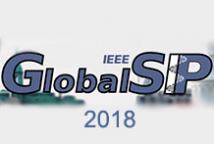
The 6th IEEE Global Conference on Signal and Information Processing (GlobalSIP) focuses on signal and information processing with an emphasis on up-and-coming signal processing themes. The conference features world-class plenary speeches, distinguished symposium talks, tutorials, exhibits, oral and poster sessions, and panels. GlobalSIP is comprised of co-located General Symposium and symposia selected based on responses to the call-for-symposia proposals.

- Read more about IMPLEMENTATION OF A HDL-CODER BASED TELECOMMAND RECEIVER APPLICATION FOR MICROSATELLITE COMMUNICATION
- Log in to post comments
In this paper the development and implementation of a Telecommand (TC) receiver application for microsatellite
communication is presented. The TC receiver application is executed and operated by a highly integrated Generic
Software-Defined Radio (GSDR) platform. This platform architecture is designed for the reliable operation of
multiple radio frequency applications on spacecraft. For the development and implementation process of the TC receiver application, a new model-based development workflow by Matlab/Simulink is used and evaluated
- Categories:
 11 Views
11 Views- Read more about Statistical detection and classification of transient signals in low-bit sampling time-domain signals
- Log in to post comments
We investigate the performance of the generalized Spectral Kurtosis (SK) estimator in detecting and discriminating natural and artificial very short duration transients in the 2-bit sampling time domain Very-Long-Baseline Interferometry (VLBI) data. We demonstrate that, after a 32-bit FFT operation is performed on the 2-bit time domain voltages, these two types of transients become distinguishable from each other in the spectral domain.
- Categories:
 35 Views
35 Views
- Read more about NON-INTRUSIVE AND NON-CONTACT SLEEP MONITORING WITH SEISMOMETER
- Log in to post comments
Monitoring sleep quality and status is important to learn health condition for improvement and prevent sleep apnea. A bed-mounted seismometer system is proposed to monitor the heart and respiratory rates, and body movement and posture, during the sleep. To effectively monitor sleep status, an innovative local maxima statistics based approach and an instantaneous property based method are developed to estimate heart and respiratory rates, respectively. These methods are more robust and stable compared to previous works.
- Categories:
 23 Views
23 Views
- Read more about LARGE SCALE RANDOMIZED LEARNING GUIDED BY PHYSICAL LAWS WITH APPLICATIONS IN FULL WAVEFORM INVERSION
- Log in to post comments
The rapid convergence rate, high fidelity learning outcome and low computational cost are key targets in solving the learning problem of the complex physical system. Guided
- Categories:
 4 Views
4 Views
- Read more about OPTIMAL DATA TASK DISTRIBUTION FOR BALANCING ENERGY CONSUMPTION ON COOPERATIVE FOG NETWORKS
- Log in to post comments
In this paper, the problem of how to balance the energy consumption during data processing in networks is investigated using a fog middleware. We first demonstrate that for a fog network with different kind of nodes, balancing the energy relies on a combinatorial optimization that is solved using graph theory. We propose a transformation of the transshipment graph problem to formulate an optimization problem that we solve with linear programming (LP).
- Categories:
 9 Views
9 Views
- Read more about A Generalizable Model for Seizure Prediction based on Deep Learning using CNN-LSTM Architecture
- Log in to post comments
- Categories:
 60 Views
60 Views
- Read more about Sketching Discrete Valued Sparse Matrices
- Log in to post comments
The problem of recovering a sparse matrix X from its sketchAXB T is referred to as the matrix sketching problem. Typically, the sketch is a lower dimensional matrix compared to X, and the sketching matrices A and B are known. Matrix sketching algorithms have been developed in the past to recover matrices from a continuous valued vectorspace (e.g., R^N×N ). However, employing such algorithms to recover discrete valued matrices may not be optimal. In this paper, we propose two novel algorithms that can efficiently recover a discrete valued sparse matrix from its sketch.
slides.pdf
- Categories:
 35 Views
35 Views
- Read more about Three-dimentional Convolution Neural Network based Encrypted Traffic Classifier for Wireless Communications
- Log in to post comments
Network traffic classification, working by associating traffic flows with specific categories or intruders, plays an important role in network management and security. For network traffic classification in wireless communications, the major challenge is encrypted data. Researchers are usually not authorized to get inner information of the traffic flows, and have to analyze traffic features. Machine learning algorithms are widely used as classifiers, and represent learning makes feature extraction more accurate by avoiding manual operation.
Ran-ppt.pdf
- Categories:
 150 Views
150 Views
- Read more about Sequential Closed-Form Semiblind Receiver for Space-Time Coded Multihop Relaying Systems
- Log in to post comments
In this letter, we present a sequential closed-form
semiblind receiver for a one-way multihop amplify-and-forward
relaying system. Assuming Khatri–Rao space-time coding at each
relay, it is shown that the system with K relays can be modeled
by means of a generalized nested PARAFAC model. Decomposing
this model intoK + 1 third-order PARAFAC models, we develop
a closed-form semiblind receiver for jointly estimating the information
symbols and the individual channels, at the destination node.
- Categories:
 17 Views
17 Views
- Read more about Obstructed Vehicle-to-Vehicle Channel Modeling for Intelligent Vehicular Communications
- Log in to post comments
In order to realize the vision of intelligent connected vehicles, it is necessary to model the vehicle-to-vehicle (V2V) channels in various realistic environments, especially when the line-of-sight (LOS) between transmitter (Tx) and receiver (Rx) is obstructed. In this paper, we model obstructed vehicle-to-vehicle (V2V) channels for the 5-GHz band through measurement-validated ray-tracing (RT) simulations. To begin, we establish a realistic V2V RT simulator through integrating three key channel features: small-scale structures (e.g.
- Categories:
 36 Views
36 Views